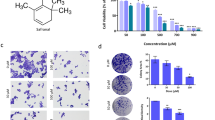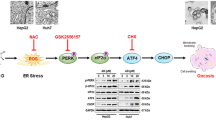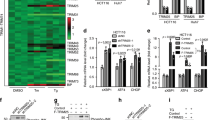Abstract
Hepatocellular carcinoma (HCC) is the most prevalent form of liver cancer, with a high recurrence rate and heterogeneity. We aimed to examine the effect of corosolic acid (CRA) on HCC. We employed transcriptomics to validate the target molecules in CRA-treated HCC cells and conducted enrichment analyses that revealed their involvement in the regulation of endoplasmic reticulum (ER) stress and apoptosis. Our experimental data indicated that CRA markedly induced apoptosis in human HCC cell lines through the mitochondrial apoptosis pathway. We also revealed that the pro-apoptotic effects of CRA depended on ER stress, as pretreatment with selective ERS inhibitor salubrinal effectively reversed CRA-induced cell apoptosis. Furthermore, the knockdown of the unfolded protein response (UPR) protein CHOP remarkably abrogated CRA-induced expression of ER stress-associated proteins. Collectively, our results suggest that CRA triggers ER stress-mediated apoptosis in HCC cells via activation of the PERK-eIF2a-ATF4 pathway. Our findings provide novel insights into the potential therapeutic strategies for HCC.








Similar content being viewed by others
Data availability
The original contributions presented in the study are included in the article/Supplementary Material. Further data can be obtained from the corresponding authors upon request.
References
Chen GM, Huang CY, Liu YY, Chen TY, Huang RL, Liang MZ, Zhang J, Xu H (2018) A network pharmacology approach to uncover the potential mechanism of yinchensini decoction. Evidence-based complementary and alternative medicine 2018:2178610. https://doi.org/10.1155/2018/2178610
Chiu H-W, Fang W-H, Chen Y-L, Wu M-D, Yuan G-F, Ho S-Y, Wang Y-J (2012) Monascuspiloin enhances the radiation sensitivity of human prostate cancer cells by stimulating endoplasmic reticulum stress and inducing autophagy. PLoS One 7(7):e40462. https://doi.org/10.1371/journal.pone.0040462
Clarke HJ, Chambers JE, Liniker E, Marciniak SJ (2014) Endoplasmic Reticulum Stress in Malignancy. Cancer Cell 25(5):563–573. https://doi.org/10.1016/j.ccr.2014.03.015
Delhalle S, Duvoix A, Schnekenburger M, Morceau F, Dicato M, Diederich M (2003) An introduction to the molecular mechanisms of apoptosis. Apoptosis: From Signaling Pathways To Therapeutic Tools 1010:1–8. https://doi.org/10.1196/annals.1299.001
Elmore S (2007) Apoptosis: a review of programmed cell death. Toxicol Pathol 35(4):495–516. https://doi.org/10.1080/01926230701320337
Evyapan G, Ay G, Comertpay G, Luleyap HU (2019) Role of endoplasmic reticulum stress response in tumorogenesis. Cukurova Medical Journal 44(1):241–248. https://doi.org/10.17826/cumj.480539
Hetz C (2009) The UPR as a survival factor of cancer cells: More than folding proteins? Leuk Res 33(7):880–882. https://doi.org/10.1016/j.leukres.2009.02.017
Hsia T-C, Yu C-C, Hsu S-C, Tang N-Y, Lu H-F, Huang Y-P, Wu S-H, Lin J-G, Chung J-G (2014) Cantharidin induces apoptosis of H460 human lung cancer cells through mitochondria-dependent pathways. International Journal of Oncology 45(1):245–254. https://doi.org/10.3892/ijo.2014.2428
Kim C, Kim B (2018) Anti-Cancer Natural Products and Their Bioactive Compounds Inducing ER Stress-Mediated Apoptosis: A Review. Nutrients 10(8). https://doi.org/10.3390/nu10081021
Li H, Zhu X, Fang F, Jiang D, Tang L (2014) Down-regulation of GRP78 enhances apoptosis via CHOP pathway in retinal ischemia-reperfusion injury. Neuroscience Letters 575:68–73. https://doi.org/10.1016/j.neulet.2014.05.042
Liu K, Fang W, Sun E, Chen YJO (2017) Roles of endoplasmic reticulum stress and apoptosis signaling pathways in gynecologic tumor cells: A systematic review. Oncology 41(8):705–716. https://doi.org/10.14348/molcells.2018.0241
Liu Y, Ye Y (2011) Proteostasis regulation at the endoplasmic reticulum: a new perturbation site for targeted cancer therapy. Cell Res 21(6):867–883. https://doi.org/10.1038/cr.2011.75
Ma B, Zhang H, Wang Y, Zhao A, Zhu Z, Bao X, Sun Y, Li L, Zhang Q (2018) Corosolic acid, a natural triterpenoid, induces ER stress-dependent apoptosis in human castration resistant prostate cancer cells via activation of IRE-1/JNK, PERK/CHOP and TRIB3. Journal of Experimental & Clinical Cancer Research 37(1):210. https://doi.org/10.1186/s13046-018-0889-x
Nakagawa H, Umemura A, Taniguchi K, Font-Burgada J, Dhar D, Ogata H, Zhong Z, Valasek MA, Seki E, Hidalgo J, Koike K, Kaufman RJ, Karin M (2014) ER Stress Cooperates with Hypernutrition to Trigger TNF-Dependent Spontaneous HCC Development. Cancer Cell 26(3):331–343. https://doi.org/10.1016/j.ccr.2014.07.001
Obexer P, Ausserlechner MJ (2014) X-linked inhibitor of apoptosis protein–a critical death resistance regulator and therapeutic target for personalized cancer therapy. Front Oncol 4:197. https://doi.org/10.3389/fonc.2014.00197
Pandey M, Choudhury H, Ying JNS, Ling JFS, Ting J, Ting JSS, Zhia Hwen IK, Suen HW, Samsul Kamar HS, Gorain B, Jain N, Mohd Amin MCI (2022) Mucoadhesive nanocarriers as a promising strategy to enhance intracellular delivery against oral cavity carcinoma. Pharmaceutics 14(4):795. https://doi.org/10.3390/pharmaceutics14040795
Peng YX, Li N, Tang FF, Qian CM, Jia TT, Liu JJ, Xu YF (2022) Corosolic acid sensitizes ferroptosis by upregulating HERPUD1 in liver cancer cells. Cell Death Discov 8(1):376. https://doi.org/10.1038/s41420-022-01169-0
Senft D, ZeA Ronai (2015) UPR, autophagy, and mitochondria crosstalk underlies the ER stress response. Trends in biochemical sciences 40(3):141–148. https://doi.org/10.1016/j.tibs.2015.01.002
Siegel RL, Miller KD, Fuchs HE, Jemal A (2022) Cancer statistics, 2022. Ca-a Cancer Journal for Clinicians 72(1):7–33. https://doi.org/10.3322/caac.21708
Tabas I, Ron D (2011) Integrating the mechanisms of apoptosis induced by endoplasmic reticulum stress. Nature Cell Biology 13(3):184–190. https://doi.org/10.1038/ncb0311-184
Thomas MB, Abbruzzese JL (2005) Opportunities for targeted therapies in hepatocellular carcinoma. Journal of Clinical Oncology 23(31):8093–8108. https://doi.org/10.1200/jco.2004.00.1537
Urano F, Wang XZ, Bertolotti A, Zhang YH, Chung P, Harding HP, Ron D (2000) Coupling of stress in the ER to activation of JNK protein kinases by transmembrane protein kinase IRE1. Science 287(5453):664–666. https://doi.org/10.1126/science.287.5453.664
Villanueva A (2019) Hepatocellular Carcinoma. N Engl J Med 380(15):1450–1462. https://doi.org/10.1056/NEJMra1713263
Wang FS, Fan JG, Zhang Z, Gao B, Wang HY (2014) The Global Burden of Liver Disease: The Major Impact of China. Hepatology 60(6):2099–2108. https://doi.org/10.1002/hep.27406
Wang X, Liu Z, Sui X, Wu Q, Wang J, Xu C (2019) Elemene injection as adjunctive treatment to platinum-based chemotherapy in patients with stage III/IV non-small cell lung cancer: A meta-analysis following the PRISMA guidelines. Phytomedicine 59:152787. https://doi.org/10.1016/j.phymed.2018.12.010
Xie J, Xu Y, Huang X, Chen Y, Fu J, Xi M, Wang L (2015) Berberine-induced apoptosis in human breast cancer cells is mediated by reactive oxygen species generation and mitochondrial-related apoptotic pathway. Tumor Biology 36(2):1279–1288. https://doi.org/10.1007/s13277-014-2754-7
Xiong S, Mu T, Wang G, Jiang XJP, cell, (2014) Mitochondria-mediated apoptosis in mammals. Protein Cell 5(10):737–749. https://doi.org/10.1007/s13238-014-0089-1
Xu Y, Ge R, Du J, Xin H, Yi T, Sheng J, Wang Y, Ling C (2009) Corosolic acid induces apoptosis through mitochondrial pathway and caspases activation in human cervix adenocarcinoma HeLa cells. Cancer Letters 284(2):229–237. https://doi.org/10.1016/j.canlet.2009.04.028
Xue Y, Zhang T, Zhang B, Gong F, Huang Y, Tang M (2016) Cytotoxicity and apoptosis induced by silver nanoparticles in human liver HepG2 cells in different dispersion media. J Appl Toxicol 36(3):352–360. https://doi.org/10.1002/jat.3199
Yang J-F, Cao J-G, Tian L, Liu F (2012) 5, 7-Dimethoxyflavone sensitizes TRAIL-induced apoptosis through DR5 upregulation in hepatocellular carcinoma cells. Cancer Chemotherapy and Pharmacology 69(1):195–206. https://doi.org/10.1007/s00280-011-1686-9
Zeeshan HMA, Lee GH, Kim H-R, Chae H-J (2016) Endoplasmic Reticulum Stress and Associated ROS. Int J Mol Sci 17(3):327. https://doi.org/10.3390/ijms17030327
Zhang X, Xu YF, Qian ZJ, Zheng WS, Wu Q, Chen Y, Zhu GQ, Liu Y, Bian ZX, Xu W, Zhang Y, Sun FY, Pan QH, Wang JY, Du LT, Yu YC (2018) circRNA_104075 stimulates YAP-dependent tumorigenesis through the regulation of HNF4a and may serve as a diagnostic marker in hepatocellular carcinoma. Cell Death Dis 9(11):1091. https://doi.org/10.1038/s41419-018-1132-6
Zhao G-X, Xu L-H, Pan H, Lin Q-R, Huang M-Y, Cai J-Y, Ouyang D-Y, He X-H (2015) The BH3-mimetic gossypol and noncytotoxic doses of valproic acid induce apoptosis by suppressing cyclin-A2/Akt/FOXO3a signaling. Oncotarget 6(36):38952–38966. https://doi.org/10.18632/oncotarget.5731
Zhou Y, Zhou B, Pache L, Chang M, Khodabakhshi AH, Tanaseichuk O, Benner C, Chanda SK (2019) Metascape provides a biologist-oriented resource for the analysis of systems-level datasets. Nature Communications 10(1):1523. https://doi.org/10.1038/s41467-019-09234-6
Acknowledgements
We thank Bullet Edits Limited for the linguistic editing and proofreading of the manuscript.
Funding
This work was supported by the National Natural Science Foundation of China (grant no. 81873150), and the Innovative project of the Health Commission of Shanghai Municipality (ZY (2021-2023)-0203-04).
Author information
Authors and Affiliations
Contributions
Yanfeng Xu and Feifeng Tang contributed to the conception and design of the study; Feifeng Tang and Yingxiu Peng performed the experiments; Feifeng Tang contributed to the acquisition, analysis, and interpretation of data; Feifeng Tang drafted the manuscript; Yanfeng Xu supervised the project; Jingjin Liu and Wenhui Gao were involved in the investigation; Yanfeng Xu revised the manuscript critically for important intellectual content. All authors have approved the final vision of this manuscript. The authors declare that all data were generated in-house and that no paper mill was used.
Corresponding author
Ethics declarations
Ethical approval
As the in vitro experiments were performed on cell lines, approval from the ethics committee was not required for this study.
Consent to participate
Not applicable.
Consent for publication
Not applicable.
Competing interests
The authors declare no competing interests.
Additional information
Publisher's note
Springer Nature remains neutral with regard to jurisdictional claims in published maps and institutional affiliations.
Supplementary information
Below is the link to the electronic supplementary material.
Rights and permissions
Springer Nature or its licensor (e.g. a society or other partner) holds exclusive rights to this article under a publishing agreement with the author(s) or other rightsholder(s); author self-archiving of the accepted manuscript version of this article is solely governed by the terms of such publishing agreement and applicable law.
About this article
Cite this article
Tang, F., Peng, Y., Liu, J. et al. Integrating network pharmacology and experimental models to examine the mechanisms of corosolic acid in preventing hepatocellular carcinoma progression through activation PERK-eIF2a-ATF4 signaling. Naunyn-Schmiedeberg's Arch Pharmacol 396, 3671–3682 (2023). https://doi.org/10.1007/s00210-023-02560-z
Received:
Accepted:
Published:
Issue Date:
DOI: https://doi.org/10.1007/s00210-023-02560-z




